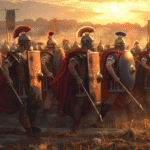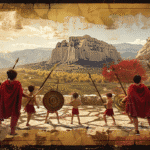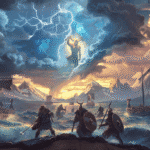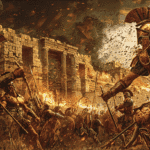Table of Contents
Who Was Miyamoto Musashi? The Legendary Swordsman Whose Philosophy Transcends Combat
In the pantheon of legendary warriors, few figures capture the imagination quite like Miyamoto Musashi—a 17th-century Japanese swordsman who reportedly fought over sixty duels without a single defeat, developed an innovative two-sword fighting style, and authored The Book of Five Rings, a text on strategy that continues to influence martial artists, business leaders, and strategic thinkers four centuries after his death.
But Musashi’s significance extends far beyond his martial prowess. He represents a unique synthesis of warrior excellence and philosophical depth, embodying the samurai ideal of bunbu ryōdō—the dual way of martial skill and cultural refinement. His life unfolded during one of Japan’s most transformative periods, as the country transitioned from centuries of civil war to the peace and rigid social order of the Tokugawa shogunate. Musashi navigated this transition as a masterless samurai (rōnin), an outsider whose very existence challenged the emerging feudal order.
Understanding Musashi matters because his teachings illuminate timeless principles about conflict, strategy, and self-cultivation that remain relevant across contexts—from literal combat to competitive business, from personal development to leadership challenges. His emphasis on adaptability, direct perception, and strategic thinking divorced from rigid technique offers frameworks for approaching any competitive or challenging situation.
This comprehensive exploration examines Musashi’s life within its historical context, analyzes his revolutionary martial innovations, explores the philosophical depths of his writings, and explains why this solitary swordsman’s ideas continue resonating in a world far removed from feudal Japan’s battlefields.
Historical Context: Japan’s Transition from War to Peace
The Sengoku Period and Samurai Culture
To understand Musashi, you need to grasp the world that shaped him. He was born around 1584, near the end of the Sengoku Period (“Warring States Period,” roughly 1467–1615)—over a century of nearly continuous civil warfare that devastated Japan.
This era featured:
Fragmented Authority: Central government had collapsed, with regional warlords (daimyō) controlling independent domains and constantly fighting to expand territory and influence.
Constant Warfare: Samurai existed primarily as professional warriors, spending careers in military campaigns. Martial skill wasn’t a hobby or cultural practice—it was life or death, with real consequences for failure.
Social Mobility: Chaos created opportunities for talented warriors to rise through merit rather than birth. Successful generals could become daimyō; defeated lords could lose everything.
Martial Innovation: Competition drove rapid development of fighting techniques, weapons, and tactics. Various sword schools emerged, each claiming superior methods.
This was the environment Musashi was born into—a world where martial excellence meant survival and advancement, where testing your skills in actual combat was expected, and where a warrior’s reputation determined opportunities.
The Battle of Sekigahara and Tokugawa Peace
In 1600, when Musashi was about sixteen, the Battle of Sekigahara decisively determined Japan’s future. This massive engagement between rival coalitions ended with Tokugawa Ieyasu’s victory, establishing the Tokugawa shogunate that would rule Japan until 1868.
The implications for samurai like Musashi were profound:
Establishment of Peace: After Sekigahara, the Tokugawa gradually pacified Japan. By Musashi’s thirties, large-scale warfare had essentially ended.
Rigid Social Order: The Tokugawa imposed strict class hierarchies. Samurai became a hereditary class serving specific lords, with limited mobility between domains.
Bureaucratization: Samurai transitioned from warriors to administrators. Many spent careers doing paperwork rather than fighting.
Obsolescence of Combat Skills: With peace, the practical need for fighting skills diminished. Swordsmanship increasingly became cultural practice and sport rather than battlefield necessity.
The Problem of Rōnin: Defeated lords’ retainers lost their positions, creating thousands of masterless samurai. These rōnin lacked the structured place in society that defined samurai identity.
Musashi lived his entire adult life in this transitional period—trained for warfare that was ending, embodying martial skills that were becoming ceremonial, and existing as a rōnin in a society that valued stable lord-retainer relationships. His achievements came in an era when the social function of his skills was disappearing.
The Duel Culture
Despite (or perhaps because of) increasing peace, dueling remained an important part of samurai culture during Musashi’s lifetime. These weren’t casual affairs but serious contests, often to the death, that served several functions:
Testing Skills: Without warfare, duels provided opportunities to test techniques against skilled opponents in high-stakes situations.
Building Reputation: Victory in famous duels enhanced a warrior’s reputation, potentially leading to employment by daimyō or students seeking instruction.
School Competition: Different sword schools competed for prestige, with representatives dueling to prove their methods superior.
Personal Honor: Challenges and duels resolved disputes over honor and reputation in a culture where status mattered intensely.
Musashi’s career of over sixty duels (according to his own account) occurred within this cultural context—they weren’t random street fights but formal contests that were part of how martial skill was demonstrated and validated in his era.
The Life of Miyamoto Musashi
Early Years and Formation (1584–1600)
Miyamoto Musashi was born in 1584 in Harima Province (modern-day Hyōgo Prefecture). His childhood name was Bennosuke. Details about his early life are fragmentary and sometimes contradictory across sources, mixing historical records with later legendary embellishment.
What we know or can reasonably infer:
Martial Heritage: Musashi’s father, Munisai (also called Shinmen Munisai), was a skilled martial artist proficient in swordsmanship and the jitte (a truncheon-like weapon used to catch sword blades). Growing up in a martial household, Musashi received early training.
Early Loss: Sources suggest Musashi lost his father young, though accounts differ on exactly when and how. This early loss may have influenced his development as a solitary figure.
First Duel: According to Musashi’s own account in his later writings, he fought his first duel at age thirteen against a warrior named Arima Kihei from the Shintō-ryū school, killing him. This remarkably young age for a lethal duel demonstrates either exceptional precociousness or possible legendary exaggeration.
Sekigahara Participation: At about sixteen, Musashi apparently participated in the Battle of Sekigahara—though on the losing side (fighting for the Western army that Tokugawa Ieyasu defeated). This early experience of large-scale warfare would have provided formative lessons about combat, strategy, and the harsh realities of defeat.
Early Development: Musashi’s youth coincided with Japan’s most violent period, where martial skills had immediate practical application. He developed in an environment where actual combat tested techniques, not theoretical training or sport matches.
The Wandering Years: Musha Shugyō (1600s–1610s)
Following Sekigahara, Musashi embarked on musha shugyō—warrior pilgrimage, a traditional practice where samurai traveled to test themselves against various opponents, learn different techniques, and build their skills and reputation.
These wandering years shaped Musashi fundamentally:
Rōnin Status: As a masterless samurai, Musashi existed outside the structured lord-retainer relationships that defined stable samurai life. This gave him freedom to travel and fight but also meant economic insecurity and social marginalization.
Serial Dueling: Musashi fought numerous duels across Japan, challenging representatives of various sword schools. These weren’t exhibitions but serious contests, many to the death, that tested his evolving techniques.
Development of Two-Sword Style: Through these duels, Musashi developed his signature Niten Ichi-ryū (“Two Heavens as One” or “Two Swords as One”) style, using both katana (long sword) and wakizashi (short sword) simultaneously—unconventional at a time when most samurai used the long sword with both hands.
Strategic Innovation: Beyond pure technique, Musashi developed sophisticated psychological and strategic approaches—studying opponents, exploiting their assumptions, using unconventional tactics, and emphasizing adaptability over rigid forms.
Social Outsider: As a rōnin deliberately fighting establishment figures from recognized schools, Musashi positioned himself as an outsider challenging orthodox methods. His victories threatened established schools’ prestige and business (students meant income for teachers).
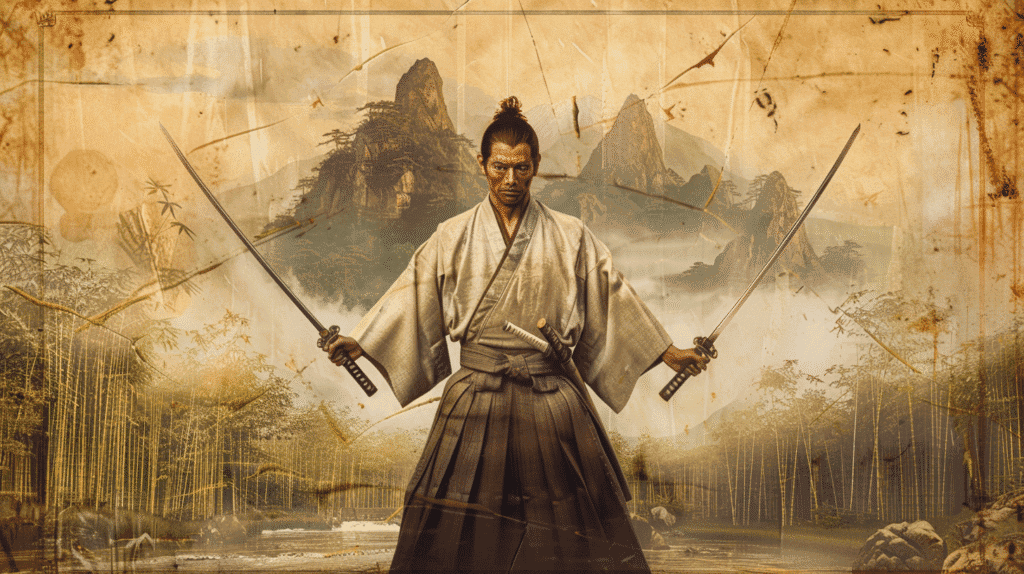
The Famous Duels
While Musashi claimed over sixty duels, several achieved particular fame and reveal his approach:
Duel with Yoshioka School (1604): One of Musashi’s most significant series of duels occurred against the Yoshioka school in Kyoto, a prestigious sword school with connections to powerful patrons. Musashi fought and killed three members of the family in succession—first Yoshioka Seijūrō, then his brother Denshichirō, then in a final confrontation faced the school’s remaining students led by the young heir Matashichirō.
The strategic and psychological dimensions of these encounters were as important as the fighting itself. Against Seijūrō, Musashi reportedly arrived late, throwing his opponent off balance. Against Denshichirō, he allegedly used a wooden sword rather than steel—a calculated insult that enraged his opponent into recklessness.
The final confrontation became a small-scale battle when the school assembled numerous students for an ambush. Musashi apparently anticipated this and brought allies, turning the duel into a melee. These encounters destroyed the Yoshioka school’s reputation and demonstrated Musashi’s willingness to fight unconventionally.
Duel with Sasaki Kojirō (1612): Musashi’s most famous duel occurred on Ganryū Island (now Funashima) near present-day Shimonoseki, against Sasaki Kojirō, a renowned swordsman celebrated for his technique.
Multiple accounts exist, but the common elements include:
- Kojirō used an exceptionally long sword (nodachi) and was famous for a technique called “Tsubame Gaeshi” (swallow reversal)
- Musashi arrived deliberately late, apparently to disturb Kojirō’s composure
- Musashi used a bokken (wooden sword) carved from an oar on the boat ride to the island, reportedly making it slightly longer than Kojirō’s famous blade
- The fight ended quickly with Musashi’s victory and Kojirō’s death
The tactical and psychological elements are significant: The delayed arrival frustrated Kojirō; the wooden sword was unconventional and unexpected; crafting it longer than Kojirō’s famous blade countered his advantage. Musashi demonstrated that understanding your opponent’s psychology and disrupting their preparation could matter more than pure technical skill.
This duel marked a turning point—Musashi was about twenty-eight years old and had defeated one of Japan’s most celebrated swordsmen. His reputation was firmly established, though it also meant he had eliminated many potential challengers.
Middle Years: Service and Teaching (1610s–1630s)
Following the Kojirō duel, Musashi’s life pattern shifted:
Attempted Service: Despite his fame, Musashi struggled to secure permanent service with major daimyō. His rōnin status, unconventional methods, and reputation as a troublesome individualist may have worked against him in an increasingly bureaucratized society that valued hierarchy and conformity.
He had several temporary service positions but never achieved the stable retainer status that defined successful samurai careers. This perpetual outsider position likely influenced his philosophical development and skepticism of rigid orthodox methods.
Teaching and Disciples: Musashi began accepting students, teaching his Niten Ichi-ryū style. Teaching required articulating his intuitive understanding of strategy and combat, likely contributing to the philosophical depth of his later writings.
Artistic Development: Like many samurai, Musashi practiced cultural arts alongside martial skills. He became accomplished in ink painting, calligraphy, and other artistic pursuits. This wasn’t just hobby—it reflected the samurai ideal of balanced cultivation in both martial (bu) and cultural (bun) arts.
Continued Dueling: While his dueling frequency decreased as he aged, Musashi continued occasional matches into his thirties and early forties, maintaining and testing his skills.
Later Years and Final Legacy (1640s)
In his final years, Musashi shifted from active warrior to writer and artist:
Service with Hosokawa Clan: Around 1640, Musashi entered service with the Hosokawa clan in Kumamoto domain (Kyushu). Lord Hosokawa Tadatoshi valued Musashi’s expertise and provided him stipend and accommodation. This belated stable position came near the end of his life.
Reigandō Cave Retreat: In 1643, Musashi withdrew to Reigandō, a cave in the mountains near Kumamoto, for meditation and writing. In this isolated retreat, he composed his masterwork, The Book of Five Rings (Go Rin no Sho), completing it just weeks before his death.
Death: Musashi died on June 13, 1645, at age approximately sixty-two. According to accounts, he died peacefully, which was unusual for a warrior who’d spent his life in violence. He supposedly composed his own death poem and gave his final instructions to disciples before passing.
The circumstances of his death—peaceful, in service, having completed his philosophical work—stand in stark contrast to the violent life he lived. He died when the samurai class was fully transitioning to peacetime bureaucrats, making him perhaps one of the last genuine combat-tested warriors of the classical tradition.
Niten Ichi-ryū: Revolutionary Martial Innovation
The Two-Sword Style
Musashi’s most distinctive innovation was Niten Ichi-ryū, employing both long sword (katana) and short sword (wakizashi) simultaneously. This was radical for several reasons:
Orthodox Tradition: Standard practice used the katana with both hands, providing maximum power and control. The wakizashi served as backup or for seppuku (ritual suicide), not as simultaneous weapon.
Physical Demands: Fighting with two swords required exceptional coordination, strength, and skill. Each hand must operate independently while maintaining overall strategic coherence.
Tactical Advantages: The two-sword style offered:
- Simultaneous attack and defense
- Multiple angles of attack creating complexity for opponents
- Flexibility to respond to different situations with different combinations
- Psychological disruption of opponents expecting conventional technique
Philosophical Dimension: Beyond tactics, using both swords reflected Musashi’s broader principle about utilizing all available resources. Why limit yourself to one sword when you carry two? The question applied beyond combat—why limit yourself to one approach, one strategy, one perspective?
Core Principles of Musashi’s Fighting Method
Beyond specific techniques, Musashi’s approach emphasized:
No Favorite Weapons: Musashi explicitly rejected attachment to particular weapons. While famous for two swords, he advocated flexibility to use whatever served best in specific circumstances—long sword, short sword, both, a stick, whatever worked.
Adaptability Over Formula: Rather than teaching rigid kata (formal exercises) that students memorized and repeated identically, Musashi emphasized understanding principles that could be applied flexibly in different situations.
Psychological Warfare: Musashi consistently exploited opponents’ psychological states—arriving late to disturb composure, using unexpected weapons, breaking assumptions about how duels should proceed.
Strategic Timing: Hyōshi (rhythm or timing) was crucial. Understanding your opponent’s rhythm, disrupting it, and striking when they’re off-balance mattered more than raw speed or strength.
Direct Perception: Musashi emphasized perceiving situations directly rather than filtering through taught concepts. See what is, not what you expect or were taught to see.
Practical Effectiveness: Musashi explicitly rejected elaborate techniques designed to look impressive. What matters is whether it works in actual combat against someone trying to kill you.
Training Philosophy
Musashi’s approach to training reflected his broader philosophy:
Real Experience: Training should approximate actual combat conditions as closely as possible. Theory matters less than repeated practice under realistic pressure.
Solo Practice: While partner training matters, individual cultivation of skills, understanding, and mental state forms the foundation. You cannot rely on teachers or partners always being available.
Continuous Study: Musashi advocated studying broadly—not just sword techniques but all martial arts, strategy, various skills. Every discipline offers lessons applicable elsewhere.
Mental Cultivation: Physical technique requires corresponding mental development. Discipline, concentration, emotional control, and strategic thinking need cultivation alongside physical skills.
Lifetime Commitment: Mastery isn’t achieved then maintained—it’s a process requiring continuous practice and refinement throughout life.
The Book of Five Rings: Strategic Philosophy
Context and Composition
In 1643, two years before his death, Musashi retreated to Reigandō cave and composed The Book of Five Rings (Gorin no Sho)—his systematic presentation of the strategic principles he’d developed through decades of combat and reflection.
Why did he write it?
Legacy: Nearing death with no heirs, the book preserved his insights for future generations—both specific disciples and martial artists generally.
Systematization: Teaching requires articulating intuitive understanding. Writing forced Musashi to systematically organize insights developed through experience.
Maturity: At sixty, after decades of reflection, Musashi had perspective on his earlier experiences that he lacked when living through them.
Cultural Context: Composing a philosophical text was expected of accomplished samurai, demonstrating cultural refinement alongside martial skill.
The Five Books: Structure and Content
The work comprises five sections named after elements from Buddhist and Daoist philosophy:
The Book of Earth (Ground): Establishes foundations—Musashi’s background, the importance of strategy, why he wrote the text, and basic principles. This section contextualizes everything that follows.
Key themes include:
- Strategy applies universally—carpenter’s principles inform warrior’s principles inform life principles
- Specialization limits understanding; study broadly
- Master principles, then transcend them
The Book of Water: Discusses strategic principles, using water’s properties metaphorically—taking the shape of circumstances, flowing around obstacles, filling spaces, having power despite appearing soft.
Specific topics include:
- Proper mental attitude for combat
- Positioning and movement
- How to hold swords
- Basic striking methods
- Timing and rhythm
- The importance of maintaining natural posture rather than adopting special “combat stances”
Musashi’s advice here is remarkably direct and practical, avoiding mystification while emphasizing principles over techniques.
The Book of Fire: Addresses combat itself—the moment of conflict. Fire represents the intense, dangerous, transformative nature of battle.
Topics include:
- Knowing your environment (place) and its effects on combat
- Reading opponents and exploiting their assumptions
- Various tactical approaches for different situations
- How to maintain strategic advantage
- When to press attacks vs. withdraw
- Fighting multiple opponents
This section contains Musashi’s most tactical advice, though even here he emphasizes principles and adaptability rather than prescriptive techniques.
The Book of Wind: Critiques other schools’ approaches, using “wind” to represent traditions, trends, and conventional wisdom that should be understood but not blindly followed.
Musashi systematically criticizes common practices:
- Using only large or only small weapons (be flexible)
- Emphasizing strength over technique or vice versa (need both)
- Focusing excessively on speed (timing matters more)
- Teaching elaborate techniques (complexity invites failure)
- Relying on formal stances (they telegraph intentions)
This isn’t mere criticism—by explaining problems with conventional approaches, Musashi clarifies his own principles by contrast.
The Book of Void (Emptiness): The shortest, most philosophical section. “Void” or “emptiness” represents the state beyond technique, where one acts spontaneously and correctly without conscious deliberation.
This is closest to Zen concepts—the “no-mind” state where training has been so internalized that conscious thought doesn’t interfere with action. Musashi provides fewer concrete instructions here because emptiness cannot be taught directly, only discovered through sustained practice.
Core Strategic Principles
Threading through all five books, several principles emerge:
Study All Things: Don’t limit yourself to your specialty. Strategy appears everywhere—in carpentry, in commerce, in governance. Patterns in one domain inform understanding of others.
Perceive That Which Cannot Be Seen: Develop intuitive understanding beyond what’s immediately obvious. Sense opponents’ intentions, anticipate developments, recognize opportunities others miss.
Adaptability: Never commit to single approaches or become predictable. Adjust continuously to circumstances, opponents, environment.
Take Initiative: Seizing and maintaining initiative—controlling the flow of events—provides decisive advantage. Force opponents to react to you rather than executing their preferred strategies.
Timing: Understanding rhythm, both your own and opponent’s, allows striking when they’re vulnerable. Proper timing makes victory easy; poor timing makes victory difficult or impossible.
Simplicity: Complicated techniques fail under pressure. Simple, direct approaches executed properly outperform elaborate maneuvers.
Body-Mind Unity: Physical techniques require corresponding mental states. Hesitation, fear, over-eagerness, or attachment to outcomes undermine technical skill.
Training as Preparation: How you train determines how you’ll perform when it matters. Practice as you’ll fight; fight as you’ve practiced.
Modern Relevance and Applications
Martial Arts Influence
Musashi’s most direct legacy remains in martial arts, where his teachings continue influencing multiple disciplines:
Kendo: Modern Japanese fencing incorporates insights from classical schools including Musashi’s. His emphasis on mental state, timing, and direct striking informs contemporary practice.
Kenjutsu: Traditional sword schools study Niten Ichi-ryū techniques and principles, preserving Musashi’s methods in relatively direct lineage.
Mixed Martial Arts: Musashi’s emphasis on adaptability, using whatever works, training broadly, and avoiding rigid attachment to specific techniques resonates with MMA philosophy.
General Martial Philosophy: Across disciplines, martial artists draw on Musashi’s principles about mental cultivation, strategic thinking, and the relationship between training and performance.
Business and Competitive Strategy
Perhaps surprisingly, The Book of Five Rings has become popular in business contexts, particularly regarding competitive strategy:
Competitive Analysis: Musashi’s emphasis on studying opponents thoroughly before engagement parallels business intelligence and competitive analysis.
Adaptability: Business environments change rapidly; Musashi’s principle of flexibility over rigid plans aligns with agile business thinking.
Psychological Dimensions: Understanding how competitors think, their assumptions and blind spots, provides advantages—parallel to Musashi’s psychological warfare.
Resource Utilization: Using all available resources, not limiting yourself to preferred tools, translates to business leveraging all assets creatively.
Timing: Knowing when to launch products, enter markets, or make moves—and when to wait—reflects Musashi’s emphasis on rhythm and timing.
Simple Execution: Overcomplicated business strategies often fail; Musashi’s preference for simplicity supports lean, focused approaches.
Critics note that applying samurai warrior philosophy to business romanticizes combat and may not translate well to non-zero-sum situations where cooperation creates value. Nevertheless, the strategic principles—adapted thoughtfully—offer useful frameworks for competitive situations.
Personal Development and Self-Cultivation
Many readers approach Musashi’s work as personal development philosophy:
Discipline and Practice: Musashi’s emphasis on consistent, dedicated practice applies to developing any skill—musical instruments, artistic pursuits, academic disciplines, athletic endeavors.
Mental Cultivation: Developing emotional control, focus, and strategic thinking benefits anyone facing challenges or pursuing ambitious goals.
Overcoming Fear: Musashi’s discussions of maintaining composure in life-threatening situations offer perspective on managing everyday anxieties and pressures.
Continuous Improvement: The concept of lifelong learning and refinement—never being “finished” developing—resonates with growth mindset thinking.
Simplicity: Musashi’s rejection of unnecessary complexity supports modern minimalist philosophies about focusing on essentials.
The challenge is adapting principles from literal life-or-death combat to everyday contexts without trivializing them or creating false equivalences between facing a sword and facing a difficult conversation.
Leadership and Decision-Making
Musashi’s principles inform thinking about leadership and high-stakes decision-making:
Decisiveness: Leaders must act despite uncertainty—Musashi’s experiences fighting with incomplete information parallel strategic decision-making.
Reading People: Understanding others’ motivations, states of mind, and likely actions is crucial for both combat and organizational leadership.
Maintaining Initiative: Leaders who set agendas and create momentum have advantages over reactive leaders—parallel to Musashi’s emphasis on seizing initiative.
Crisis Management: Musashi’s emphasis on maintaining composure and clear thinking in extreme pressure translates to crisis leadership.
Vision and Adaptation: Balancing strategic direction with tactical flexibility—having principles while adapting execution—reflects challenges leaders face.
Translations, Interpretations, and Scholarly Challenges
Translation Issues
The Book of Five Rings was written in classical Japanese with Buddhist and Daoist philosophical influences, creating significant translation challenges:
Multiple English Versions: Major translations include:
- Victor Harris (1974): Early, widely distributed but sometimes criticized for interpretive liberties
- Thomas Cleary (1993): Emphasizes philosophical and spiritual dimensions
- William Scott Wilson (2002): Scholarly translation with extensive historical notes
- Alexander Bennett (2018): Recent translation emphasizing martial context
Different Emphases: Translations vary in how they handle Musashi’s technical martial vocabulary, philosophical terms, and ambiguous passages—leading to sometimes significantly different English versions.
Cultural Context: Understanding the text requires familiarity with samurai culture, Japanese martial traditions, Buddhist and Daoist philosophy, and Musashi’s historical context—knowledge many Western readers lack.
Modern Japanese Distance: Even Japanese readers find Musashi’s classical language challenging, requiring translations into modern Japanese alongside English versions.
Separating History from Legend
Musashi’s historical reputation faces challenges:
Self-Reporting: Much of what we “know” about Musashi comes from his own writings, which naturally present his perspective favorably.
Contemporary Sources: Limited contemporary documentation exists about Musashi—many details come from later accounts that may incorporate legendary elaboration.
Numerical Claims: The “over sixty duels undefeated” claim is impossible to verify. Some scholars suspect exaggeration or redefinition of what counts as a “duel.”
Legendary Accretion: Like many historical figures, Musashi accumulated legendary stories over centuries—separating what actually happened from later embellishment is difficult.
What scholars confidently assert:
- Musashi was a real historical figure active in early 17th century
- He achieved significant reputation as a swordsman
- He developed Niten Ichi-ryū style
- He fought notable duels including one with Sasaki Kojirō
- He wrote The Book of Five Rings and other texts
- He pursued artistic practices alongside martial arts
What remains uncertain:
- Exact number and circumstances of most duels
- Whether he was truly undefeated or if some losses went unrecorded
- Details of his early life and family
- Extent of exaggeration in various legendary stories
Critical Perspectives
Modern scholars and martial artists offer various critiques:
Historical Context Matters: Musashi’s specific techniques developed for specific circumstances—applying them outside that context requires significant adaptation and interpretation.
Romanticization: Popular culture often romanticizes samurai generally and Musashi specifically, downplaying the violence and brutality of his actual life and era.
Oversimplification: Condensing Musashi’s complex ideas into business maxims or self-help principles risks losing important nuance and context.
Cultural Appropriation Concerns: Westerners adopting samurai philosophy without understanding cultural context or the problematic aspects of warrior cultures raises ethical questions.
Limited Universality: While Musashi’s principles may apply broadly, they emerged from specific cultural values (honor, martial excellence, hierarchical society) that differ from modern democratic, individualistic cultures.
These critiques don’t invalidate Musashi’s insights but encourage thoughtful, contextual engagement rather than uncritical application.
Cultural Legacy and Modern Reception
Musashi in Japanese Culture
In Japan, Musashi occupies a particular cultural space:
National Icon: He represents certain Japanese cultural ideals—dedication to craft, continuous self-improvement, synthesis of martial and cultural arts.
Literary Figure: Eiji Yoshikawa’s 1935 novelization of Musashi’s life (Musashi) became a cultural phenomenon, shaping how modern Japanese understand the historical figure.
Tourist Sites: Locations associated with Musashi—Ganryū Island (duel site), Reigandō cave, various monuments—attract tourists and pilgrims interested in samurai history.
Educational Figure: The Book of Five Rings is studied in schools and martial arts training, though often alongside other classical texts rather than treated as uniquely authoritative.
Complex Symbol: Musashi represents both admired qualities (discipline, excellence) and problematic aspects of Japanese militaristic history, making him a complex cultural symbol rather than uncomplicated hero.
Global Popular Culture
Internationally, Musashi appears in various media:
Film: Multiple Japanese films depict Musashi’s life and duels, from early cinema through contemporary productions.
Manga and Anime: Series like Vagabond (based on Yoshikawa’s novel) introduce Musashi to younger global audiences through comic medium.
Video Games: Musashi appears as a character in numerous games, often as master swordsman or strategic genius.
Literature: Western historical novels and alternative history fiction incorporate Musashi, often positioning him as ultimate warrior figure.
Business Books: Numerous books explicitly apply Musashi’s principles to business strategy, though quality and faithfulness to the source varies considerably.
These popular representations both spread awareness of Musashi and risk replacing historical complexity with simplified iconic images.
Conclusion: The Enduring Relevance of Musashi’s Way
Miyamoto Musashi lived over four centuries ago in a culture vastly different from our own, pursuing excellence in skills—sword fighting—that no longer hold practical importance. Yet his ideas continue resonating because they address fundamental human challenges that transcend specific historical contexts.
Musashi’s core insights include:
Adaptability Beats Rigid Excellence: Mastering fixed techniques matters less than developing capacity to adapt to novel situations. This applies whether facing unpredictable opponents or navigating changing environments.
Mental State Determines Performance: Physical skills require corresponding mental cultivation. Fear, attachment, distraction, over-eagerness—these mental states undermine technical ability. Developing emotional control and focused awareness matters across disciplines.
Direct Perception Over Concepts: Seeing situations as they are rather than through filters of expectation, theory, or received wisdom allows responding effectively. This requires practice transcending conceptual thinking.
Simplicity Under Pressure: Complex approaches fail when circumstances are intense and stakes are high. Effectiveness comes from simple, direct actions executed properly—whether in combat, crisis management, or high-pressure performance.
Continuous Practice: Mastery isn’t achieved then maintained—it requires ongoing practice and refinement throughout life. Complacency leads to stagnation; sustained engagement with challenges promotes growth.
Universal Principles: Patterns appearing in one domain often apply elsewhere. Studying broadly rather than narrowly, seeing connections between different fields, develops richer understanding.
Taking Initiative: Creating momentum and forcing others to react provides decisive advantages over passive reaction. This applies in combat, business competition, and life generally.
These principles remain relevant because they address timeless aspects of human psychology, learning, performance under pressure, strategic thinking, and self-cultivation that don’t change fundamentally despite massive shifts in technology and social organization.
The challenge is thoughtful application: Musashi’s context—a warrior culture where honor mattered more than life, where lethal violence resolved disputes, where social hierarchy was rigid—differs profoundly from modern democratic, individualistic, technologically advanced societies. Simply transplanting samurai principles into modern contexts risks romanticizing violence, trivializing serious life-or-death situations, or misapplying ideas that don’t fit different circumstances.
But approached critically and adapted thoughtfully, Musashi’s insights offer valuable frameworks for understanding conflict, strategy, excellence, and self-development. The man who spent his life perfecting the ability to kill other humans with swords paradoxically left teachings about clarity, simplicity, adaptability, and continuous self-cultivation that apply far beyond the battlefield.
Musashi’s ultimate legacy might be demonstrating that even the most specialized pursuit—in his case, sword fighting—when approached with sufficient depth and reflection, reveals universal principles about effectiveness, excellence, and the human condition. The specifics of his techniques matter primarily to martial artists studying classical Japanese sword fighting. The principles underlying those techniques—perception, timing, adaptability, mental cultivation—matter to anyone pursuing excellence in any challenging endeavor.
Four hundred years after his death, Miyamoto Musashi remains relevant not because we need to know how to fight with two swords but because we still face the challenges of developing skills, performing under pressure, thinking strategically, and cultivating ourselves mentally and physically. The tools change; the fundamental human questions persist. Musashi’s life and teachings offer one powerful set of answers—not the only answers, but ones tested in the ultimate crucible of life-or-death combat and refined through decades of practice and reflection.
Additional Resources
For readers interested in deeper engagement with Musashi and his teachings:
- William Scott Wilson’s translation of The Book of Five Rings (Shambhala Publications, 2002) offers scholarly rigor alongside accessible English, with extensive historical and cultural notes that contextualize Musashi’s ideas.
- The Hyōhō Niten Ichi Ryū website maintained by practitioners of Musashi’s sword school provides information about the technical martial tradition he founded and its contemporary practice.
Check out our sister sites at Curious Fox Learning.



